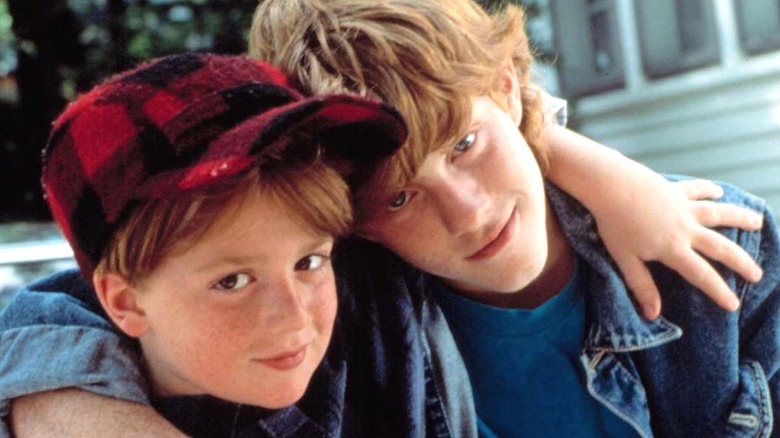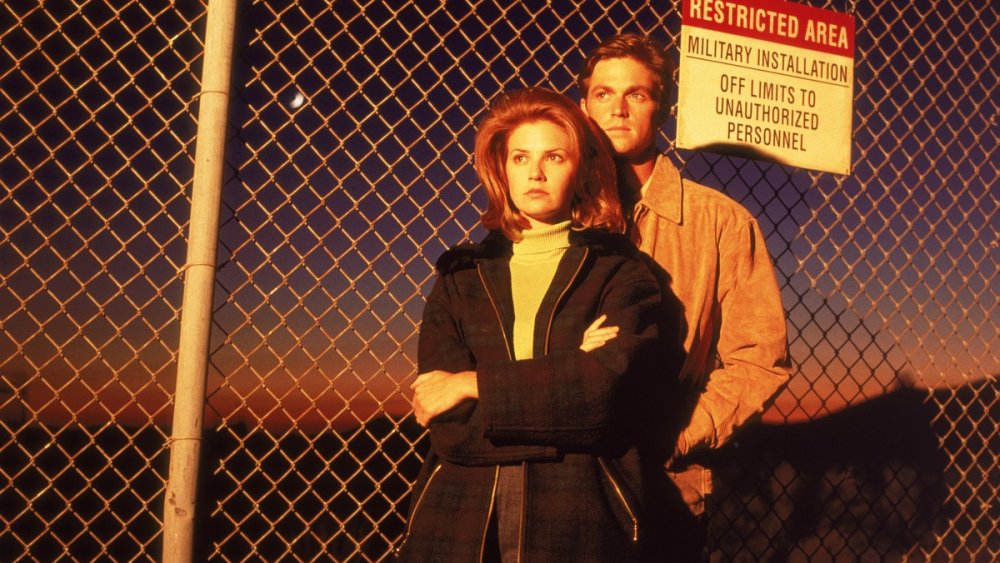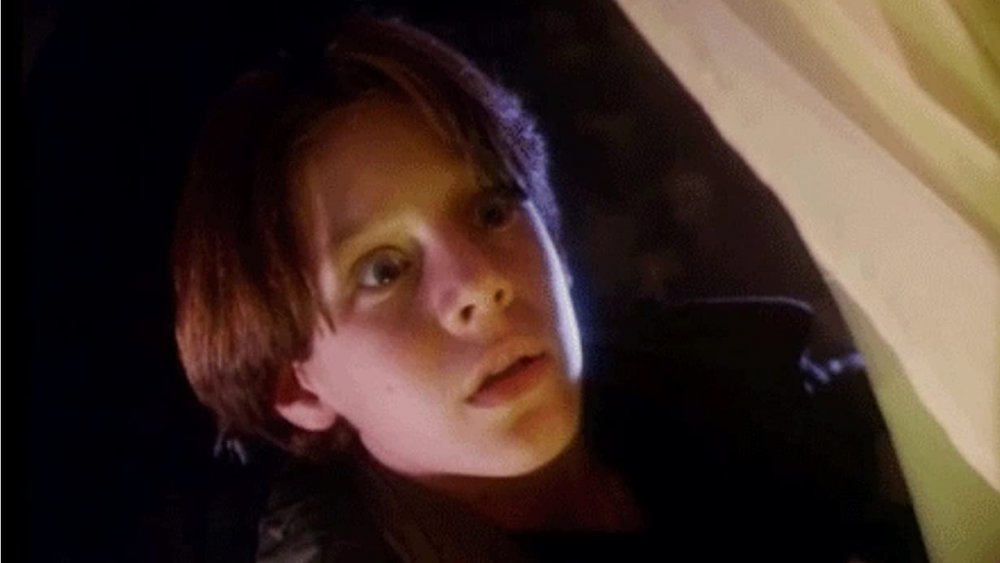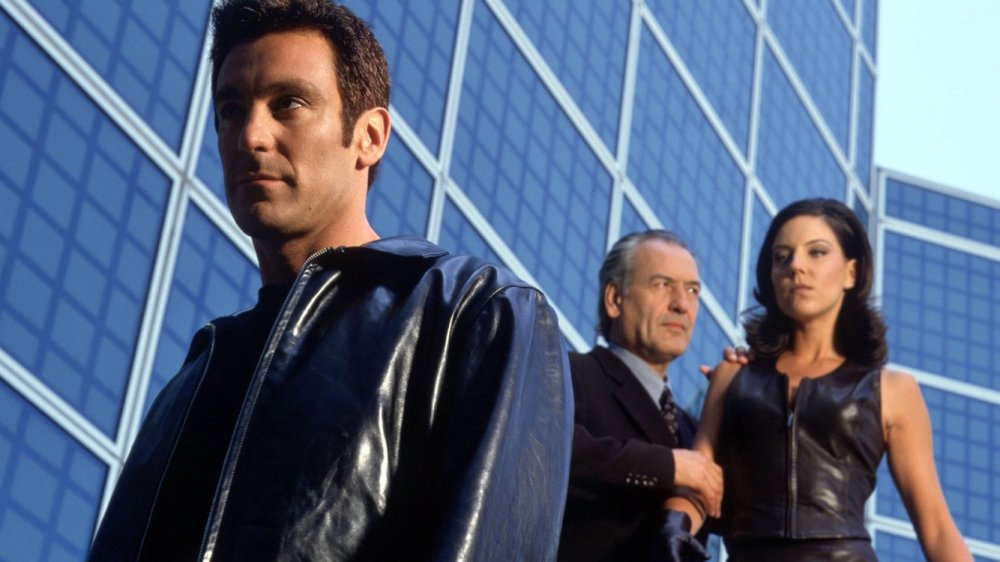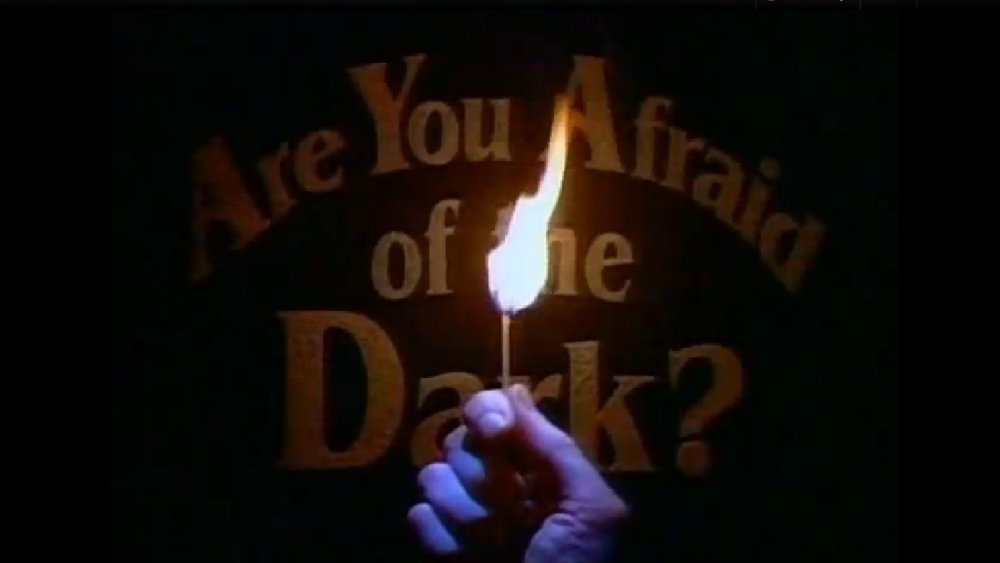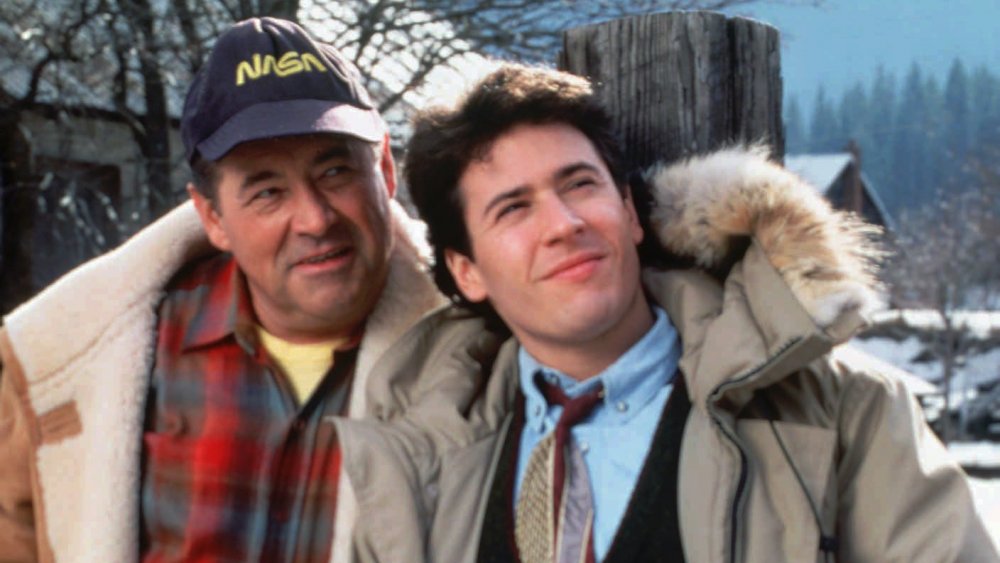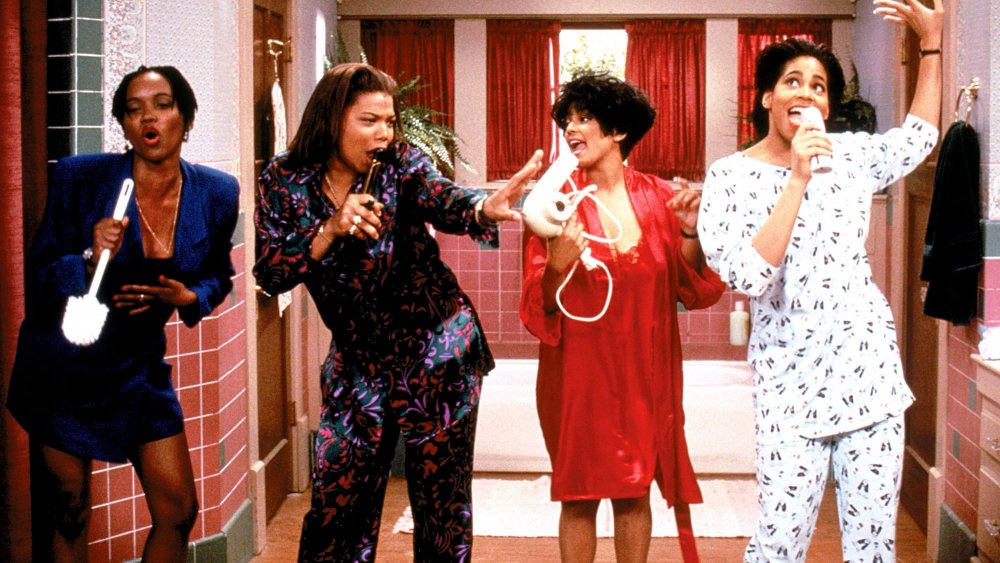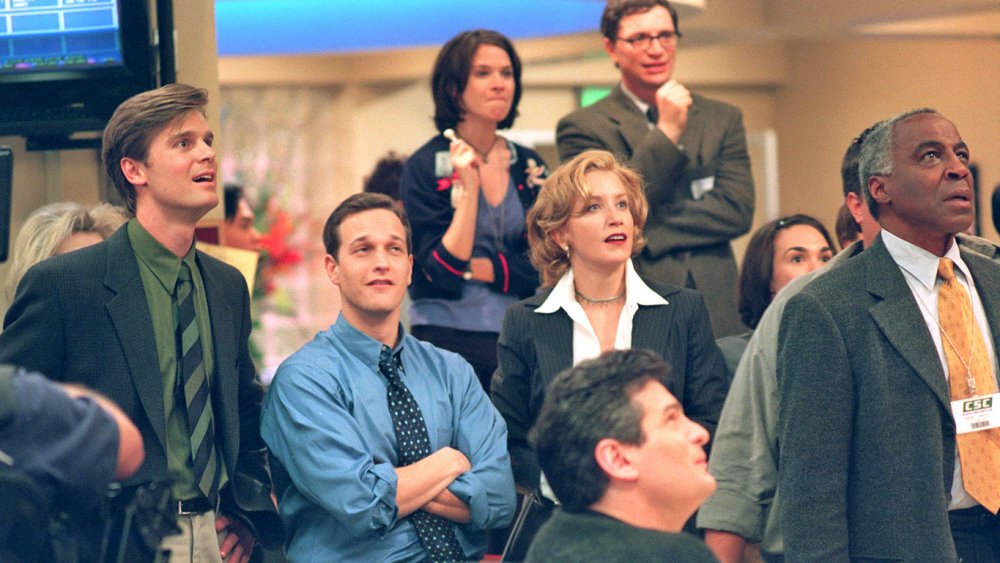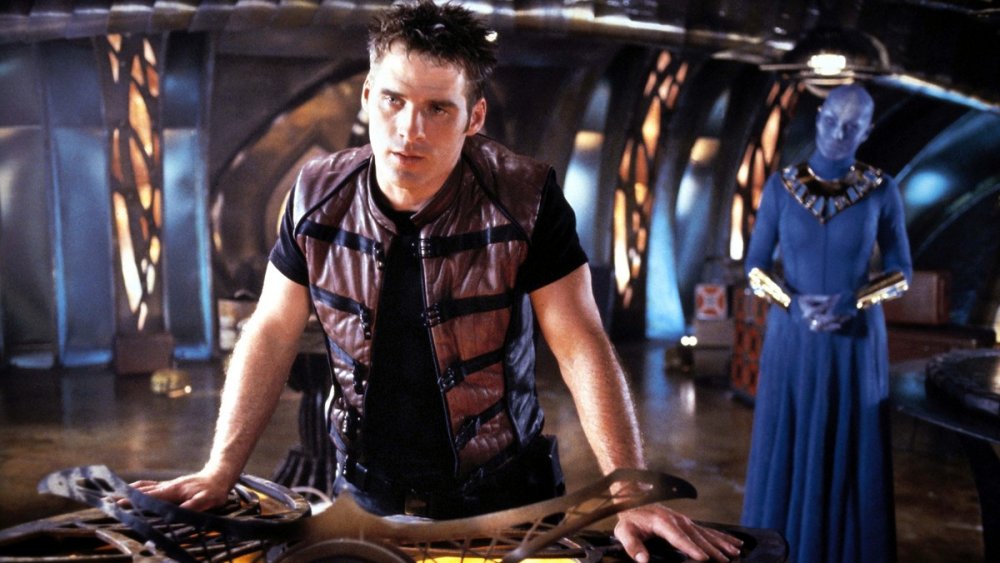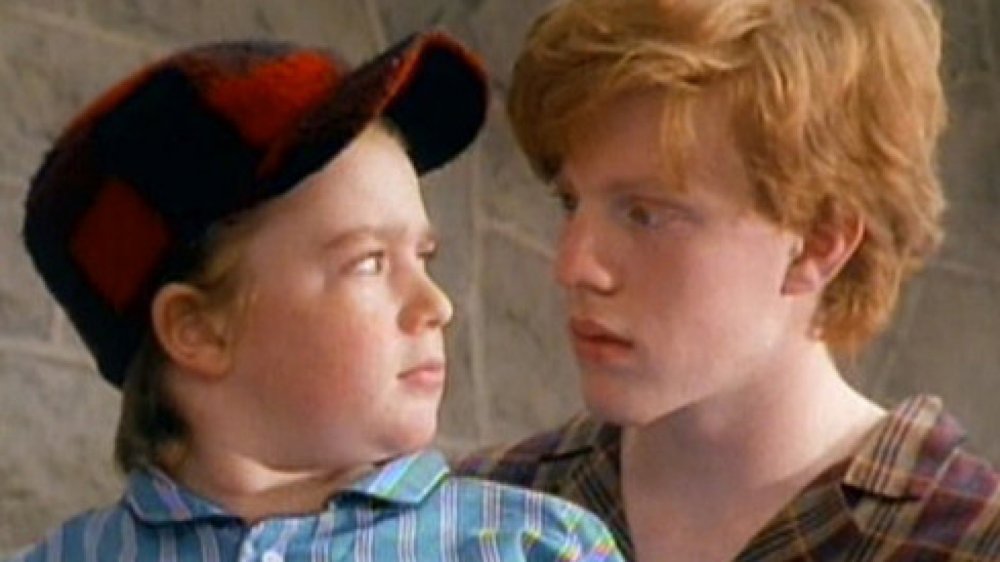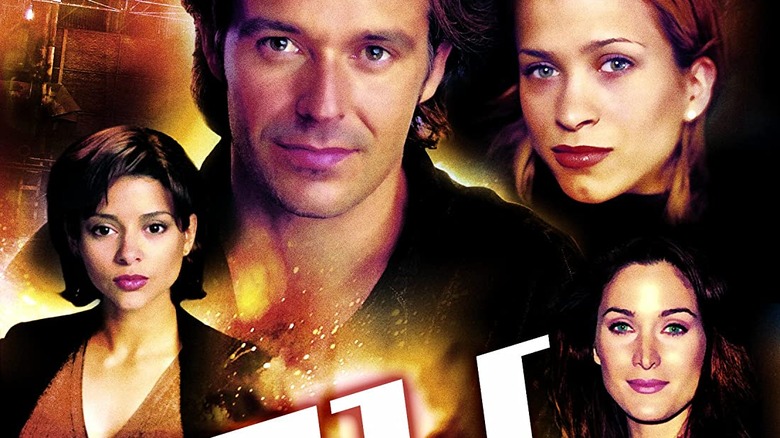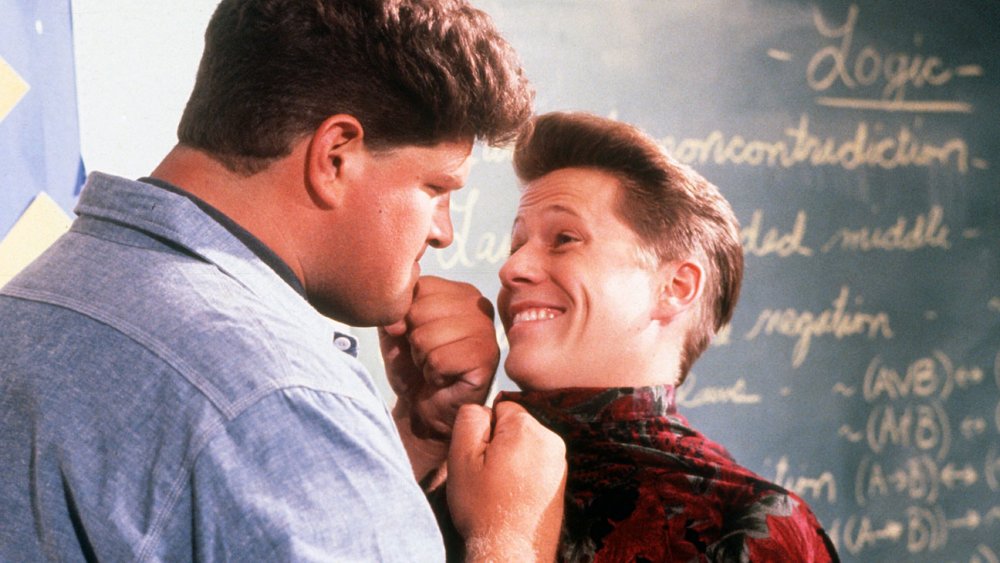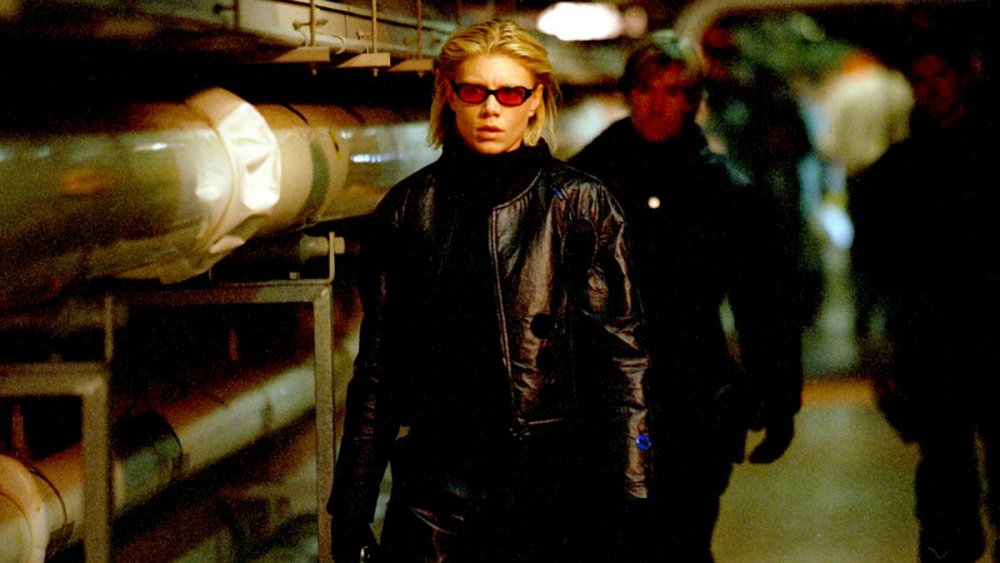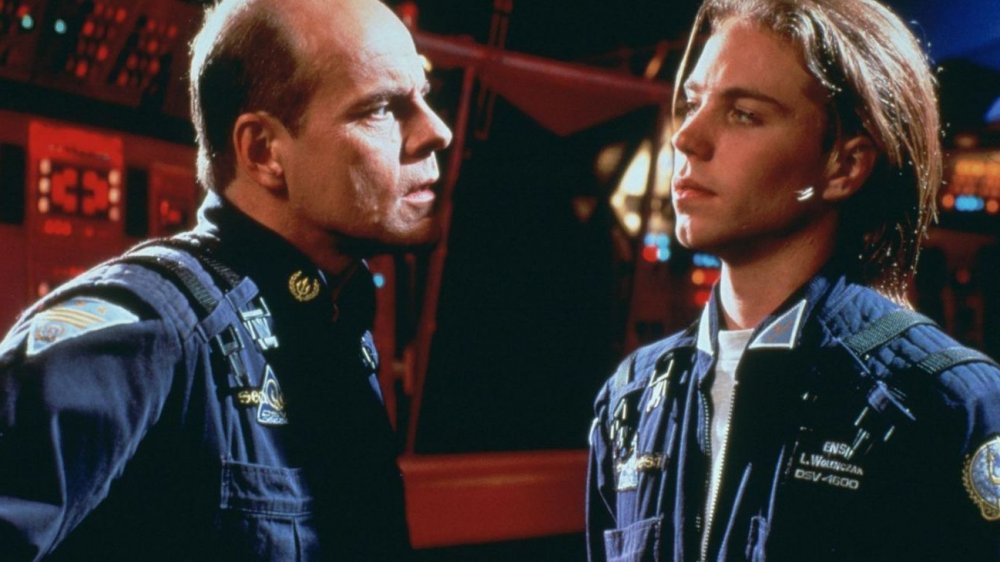Underrated '90s TV Shows You Forgot Existed
The television of the '90s gave us plenty of memorable, award-winning, and groundbreaking series. Shows like Twin Peaks, Law & Order, The Fresh Prince of Bel-Air, and Buffy the Vampire Slayer would come to define a decade that saw the rise of cable programming and series that attracted rabid cult fanbases even as they scored niche viewer ratings. While those and many other shows are fondly remembered and rewatched on streaming services today, there are dozens of others that have been largely forgotten — shows that tried to compete with the likes of The X-Files or Saved by the Bell, but were hampered by poor time slots, network disputes, and often just being a little too ahead of their time. These shows may not make every critic's top 10 list for '90s TV, but that doesn't mean they aren't deserving of praise. For whatever reason, they're rarely part of the conversation today, but these forgotten '90s shows are definitely worth a revisit.
Dark Skies
Airing between 1996 and 1997, NBC's Dark Skies was a sci-fi drama that delved into the world of aliens, government conspiracies, and 1960s pop culture icons. Starring Eric Close as Congressional aide turned alien hunter John Loengard, Dark Skies jumped on the sci-fi bandwagon that Fox's X-Files had built and rode it for everything it could. It never quite caught on, and NBC canceled the show in its first season, in spite of series creators Bryce Zabel and Brent Friedman having much more story to tell.
While Dark Skies certainly borrowed elements from The X-Files (with varying degrees of success), the show had at least one really good thing going for it: the Hive, the invading alien race at the center of the series' conflict. Comprised of parasitic creatures called Ganglions, the Hive would infiltrate by means of attaching to a host's brain and taking control of its body. The Hive began its invasion of Earth in the '40s, when it hitched a ride with the Greys — those Roswell aliens famous for human abduction and experimentation. In the world of Dark Skies, the Greys are just as much victims of the Hive as humans are, and everything we think we know about them is a lie.
Dark Skies takes this alien conspiracy and partners it with historical characters and events — everything from the Beatles' first appearance on The Ed Sullivan Show to the JFK assassination now has ties to the Hive and the secret government organization Majestic 12. One thing's for sure: you'll never look at cows the same way after Dark Skies.
Eerie, Indiana
Eerie, Indiana arrived at the onset of the teen supernatural craze that took hold in the mid-to-late '90s, but unlike more popular successors like 1995's Goosebumps or 1997's Buffy the Vampire Slayer, it was relegated to a one-season run, between 1991 and 1992. The show centered on Marshall Teller (a pre-Hocus Pocus Omri Katz), who moves with his family to Eerie, Indiana (pop. 16,661) and quickly discovers that things are not as idyllic as they appear. Along with his best friend Simon (Justin Shenkarow), Marshall takes stock of all the weirdness he runs into, preserving evidence in a locker that only he holds the key to.
The show may have been marketed to kids, but its appeal stretched much further. The show's stories vacillated between quirky (Tupperware-like containers that preserve human beings) and genuinely dark (a girl's personality changes after she receives a heart transplant from a boy who dies in a terrible accident), often finding space between. Joe Dante (Gremlins) directed several of the series' best episodes, including the premiere, and his signature comedic style set the tone for the entire season. Fox made an attempt to recreate the series in 1998 with Eerie, Indiana: The Other Dimension, but it — like most copies — couldn't recapture the magic of the original.
The Pretender
The Pretender, which ran for four seasons on NBC from 1996 to 2000, was one of the wackiest creations the network put out in the '90s, which is saying something, considering NBC was also responsible for The Cosby Mysteries in 1994. Jarod (Michael T. Weiss), a genius with a knack for impersonating any professional role, escapes from a secret research facility called the Centre, where he's been held since childhood and used in experiments that revolve around his "Pretender" abilities. Hot on his heels are Sydney (Patrick Bauchau), the psychiatrist in charge of Jarod's experiments, Broots (Jon Gries), a computer expert, and Miss Parker (Andrea Parker), a Centre operative with a penchant for high-heeled boots and cigarettes whose over-the-top villainy is reminiscent of Cruella de Vil, if Cruella de Vil had been a government employee. Each episode saw Jarod take on a new role in an attempt to bring justice to those the system had failed while simultaneously looking for answers about his past.
The show was a wild ride from start to finish, but in the very best way possible. Jarod's brand of justice was of the poetic variety, and episodes would generally end with him putting wrongdoers in the same position as they'd put their victims. As the seasons progressed, the story got even stranger — secret siblings arrived, clones were revealed, and Jarod pretended to be everything from a black market arms dealer to an escort. The show ended on a cliffhanger, which series creators attempted to tie up with two made-for-TV movies, The Pretender 2001 and The Pretender: Island of the Haunted.
Are You Afraid of the Dark?
"Submitted for the approval of the Midnight Society" were words that many a young horror fan looked forward to hearing Saturday nights on Are You Afraid of the Dark?. Following a group of teens who meet in the woods every week to share scary stories, the show was a part of Nickelodeon's SNICK lineup for four years between 1992 and 1997, although the series itself ran for a total of seven seasons between 1990 and 2000, beginning first on the Canadian network YTV.
Are You Afraid of the Dark? was a well-written jaunt through the greatest of childhood horrors. Episodes like "The Tale of Laughing in the Dark" — in which a funhouse clown named Zeebo comes after a kid who steals his nose — are, to this day, remembered as some of the most terrifying small-screen stories of the decade. Three years after its initial run ended in 1996, Nickelodeon renewed the series for two more seasons, bringing in a mostly new core cast of characters and set of horror stories about life or death board games, cannibal neighbors, and killer digital pets. Are You Afraid of the Dark? got an overhaul in 2019 — its format changed to a three-episode miniseries that focused more on the Midnight Society itself and on a central villain that haunts its members.
Northern Exposure
When Northern Exposure premiered on CBS in the summer of 1990, scripted dramas had taken a back seat to 30-minute comedies — shows like Cheers and Roseanne ruled the airwaves, while Murder, She Wrote, the top drama at the time, ranked twelfth overall, just behind Designing Women. Northern Exposure was like none of these. The hourlong drama centered on Joel Fleischman (Rob Morrow), a young New York physician bound by the terms of a student loan agreement to spend the first four years of his professional life practicing medicine in Cicely, Alaska, population 215. The proverbial fish out of water, Joel struggles to find his place among Cicely's residents, but over the course of several seasons (prior to Morrow's exit from the series, anyway), Joel eventually warms up to his new home and its quirky inhabitants.
Created by Joshua Brand and John Falsey, the pair behind the critically acclaimed '80s medical drama St. Elsewhere, Northern Exposure would go on to become one of the most celebrated shows of its time, garnering over 50 award nominations and nearly 30 wins, including best drama series at both the Golden Globes and the Emmys. It managed to strike a balance between its eccentricity and some genuinely progressive storylines (including featuring one of the first LGBT marriages on primetime television), and it introduced TV audiences to John Corbett an entire decade before he romanced Carrie Bradshaw. Still, it isn't one that pops up on top TV lists these days, which is a shame, because it certainly was a standout while it was around.
Living Single
In 1993, Living Single took the concept of a group of friends living and working together in New York and created a show that wasn't just successful... it would set the stage for what much of the television sitcom landscape would look like in the following years. The show centered on four friends: roommates Khadijah James (Queen Latifah), the editor of Black magazine Flavor, Synclaire James (Kim Coles), Khadijah's cousin and an aspiring actress, and Regine Hunter (Kim Fields), Khadijah's childhood friend and a boutique buyer, as well as their neighbor Maxine Shaw (Erika Alexander), Khadijah's college roommate and an attorney. For five seasons, Living Single tackled everything from jealous coworkers to married boyfriends. The cast had incredible chemistry, and it showcased stories that hadn't been seen onscreen before.
Series creator Yvette Lee Bowser had experience in TV prior to Living Single — she'd worked on Hangin' with Mr. Cooper and the Cosby Show spinoff A Different World. But Living Single gave Bowser the opportunity to tell the stories she really wanted to. She told The Atlantic in 2018, "[I]t began with the realization that if this industry was really only going to cater to and embrace white people ... I wasn't gonna be here for long. So that was my impetus for getting into the world of development and creation of shows about us." Today, Living Single's influence is still felt on shows like How I Met Your Mother or Insecure. And Bowser, who's produced more recent series Black-ish and Dear White People, continues to prove she's a force in the industry.
Sports Night
A year before The West Wing, and a decade before The Newsroom, Aaron Sorkin waded into the TV waters with Sports Night, a half-hour dramedy that ran on ABC for two seasons from 1998 to 2000. Think of it as something like a rehearsal for The Newsroom — Sports Night, like Newsroom, focused on the inner workings of a nightly TV series. In this case, it's a show that mirrors ESPN's SportsCenter — a breakdown of sports highlights by a pair of co-anchors (Josh Charles and Peter Krause). Felicity Huffman plays Diana Whitaker, the show's executive producer and counterbalance to its stars.
Sports Night paved the way for the kind of TV that Sorkin would become famous for in later years — the rapid-fire dialogue, moral speeches, and the hero versus the villains in charge theme are all there. It's like Sorkin light, in that there are shades of the work he would go on to do, but it isn't quite there. Blame it on ABC — Sorkin apparently fought with the network the entire time Sports Night was on the air, and he certainly didn't approve of the show's laugh track, which is often cited as one of its greatest faults. Sports Night may not have been quite a success in 1998, but it continues to have something of a cult following today. Maybe in the age of TV reboots, this is one we'll someday see again... just, not on ABC.
Farscape
By the late '90s, stories set in far-off universes where human beings intermingled with alien races of all shapes and sizes had become a familiar thing. The Star Trek resurgence had already produced three series, Warner Bros. had Babylon 5, and Showtime had launched Stargate SG-1. It was only a matter of time before Syfy (then the Sci-Fi Channel) would try to make its mark on science fiction/fantasy television. In 1999 it did, with Farscape, a bizarre gem of a show produced by the Jim Henson Company.
Farscape told the story of John Crichton (Ben Browder), an American astronaut who gets shot through a wormhole and winds up taking refuge aboard a living ship populated by all manner of beings. Many of those beings were portrayed by puppets, and the show, as such, had a little bit of a Dark Crystal vibe (which it gave a nod to in both seasons 2 and 3). Today, Farscape's impact on science fiction television continues to be felt. Following its cancellation, the series was given a three-hour miniseries in 2004 called The Peacekeeper Wars, and it has gone on to inspire books, comics, and a video game. In 2014, there were rumblings of a movie that never quite reached production, although series creators have never given up hope that it will come to pass.
The Adventures of Pete & Pete
While The Adventures of Pete & Pete technically got its start in 1989 in the form of minute-long shorts, it wasn't until 1993, when the series was given a proper full season on Nickelodeon, that it really came into its own. Following brothers Big Pete (Michael C. Maronna) and Little Pete (Danny Tamberelli), Pete & Pete explored the trials and tribulations of the average suburban upbringing in a way that was anything but. The brothers confronted villains like "Pit Stain" and Mike "The Urinator" Uplinger. They were joined by friends like Artie, the Strongest Man in the World (Toby Huss) to take on solving childhood mysteries that involved lovestruck bus drivers and lonely ice cream vendors, all while Big Pete served as our relatable narrator, giving us insight into the weird world that was Wellsville.
The Adventures of Pete & Pete was one of those truly original, totally bizarre series that really managed to capture the weirdness of the early '90s. Both "Petunia," Little Pete's forearm tattoo, and "Mom's Plate," the metal plate in their mother's head that could pick up and broadcast radio stations, had their own opening credits. But it was weird in a way that felt absolutely normal — series creator Will McRobb told HuffPost in 2013 that much of the show's success came from its "love of misfits, oddballs and the semi-surreal nature of everyday life," and said, "There was such intense emotional connection, because someone was speaking for them and to them and experiencing all that emotion and confusion and happiness and sadness."
F/X: The Series
Based on the 1986 thriller F/X, F/X: The Series centered on Rollie Tyler (Cameron Daddo), a New York-based effects artist who's recruited by NYPD detective Leo McCarthy (Kevin Dobson) to help take down the city's criminals. The show only lasted for two seasons between 1996 and 1998, but it managed to pack a ton of story into its 39-episode run (including multiple kidnappings and the death of one of its main characters at the end of season 1).
F/X: The Series sort of got caught up in continuously trying to outdo itself as time went on — one season 2 episode uncovered a shadow conspiracy that involved multiple deaths between states, a militia cell, and a government scientist. But the show overall was entertaining, and it put an interesting spin on the police procedural that dominated TV screens throughout the '90s. It also served as one of Carrie-Anne Moss' breakthrough roles, coming out only a few years before her appearance in the Wachowskis' 1999 hit The Matrix.
Parker Lewis Can't Lose
In the 1980s, much of what aired on TV was focused around family programming (Growing Pains, The Cosby Show) or trended toward adult action and adventure (Magnum, P.I., Miami Vice). The '90s saw a substantial shift, with more series catering to younger audiences than ever before. Shows like Saved by the Bell dominated Saturday morning blocks, and by the end of the decade, entire networks would be devoted to young adult programming. Premiering at the onset of the '90s was Fox's Parker Lewis Can't Lose, a 30-minute comedy about a high schooler (Corin Nemec), his best friends Mikey (Billy Jayne) and Jerry (Troy W. Slaten), and their never-ending war with their principal (Melanie Chartoff).
For three years, Fox managed to have one of the most original, totally out there shows as a part of its lineup. Parker Lewis Can't Lose was meta in the same way as Ferris Bueller's Day Off, but it also boasted a surreal quality that was completely unlike anything else on the air. The show might not have been as popular as Saved by the Bell at the time, but it continues to have a cult following to this day. And if the success of later sitcoms like Scrubs is any indication, Parker Lewis was definitely doing something right.
La Femme Nikita
Luc Besson's 1990 film La Femme Nikita spawned an entire franchise of movies and TV series, including two film remakes (the Hong Kong action film Black Cat and the American action thriller Point of No Return). The series spinoff La Femme Nikita was a US/Canada collaboration that starred newcomer Peta Wilson as the titular character, a woman falsely imprisoned for the murder of a police officer who gets recruited into Section One, a top-secret counterterrorism organization that forces her to bend to its will.
La Femme Nikita built a strong and fierce fanbase, which kept the show on the air for a total of five seasons between 1997 and 2001. Even two decades later, much of the series holds up — its writing and editing don't feel altogether tied to the '90s, and the show's performances are realistic, grounded, and often moving. Wilson is exceptional, and La Femme Nikita was one of few series at the time that portrayed a female character as a lead action star in a way that was neither cheesy nor overtly sexual.
In 2010, the concept was again retooled as Nikita, this time for the CW and with Maggie Q as its lead. Although that version stayed on the air for four seasons, it never quite recaptured the magic of the USA production.
seaQuest DSV
At a time when the bulk of TV science fiction took place beyond the stars, seaQuest DSV headed into the depths of the ocean instead. In the year 2018, humankind has destroyed the planet, save for the ocean floor. New colonies have formed there, and the crew of the seaQuest, a deep submergence vehicle operated by the United Earth Oceans Organization (UEO), has been tasked with keeping the peace. Led by Captain Nathan Bridger (Roy Scheider) — at least for its first two seasons — the crew would often find themselves in situations like mediating ownership of artifacts from the Library of Alexandria with the help of psychics, or dealing with a deadly space virus that somehow managed to survive thousands of feet underwater.
If it sounds a lot like Star Trek, it is. seaQuest DSV may not have been the most original series of the '90s, but it did at least try to do something different. There was a heavy focus on environmental protection, and although it didn't always successfully balance science fiction with mainstream TV drama, it did have a talking dolphin named Darwin who was a maybe more important member of the crew than half of those cut at the beginning of season 3.
